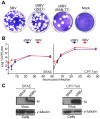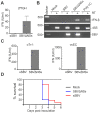Schmallenberg virus pathogenesis, tropism and interaction with the innate immune system of the host
- PMID: 23326235
- PMCID: PMC3542112
- DOI: 10.1371/journal.ppat.1003133
Schmallenberg virus pathogenesis, tropism and interaction with the innate immune system of the host
Abstract
Schmallenberg virus (SBV) is an emerging orthobunyavirus of ruminants associated with outbreaks of congenital malformations in aborted and stillborn animals. Since its discovery in November 2011, SBV has spread very rapidly to many European countries. Here, we developed molecular and serological tools, and an experimental in vivo model as a platform to study SBV pathogenesis, tropism and virus-host cell interactions. Using a synthetic biology approach, we developed a reverse genetics system for the rapid rescue and genetic manipulation of SBV. We showed that SBV has a wide tropism in cell culture and "synthetic" SBV replicates in vitro as efficiently as wild type virus. We developed an experimental mouse model to study SBV infection and showed that this virus replicates abundantly in neurons where it causes cerebral malacia and vacuolation of the cerebral cortex. These virus-induced acute lesions are useful in understanding the progression from vacuolation to porencephaly and extensive tissue destruction, often observed in aborted lambs and calves in naturally occurring Schmallenberg cases. Indeed, we detected high levels of SBV antigens in the neurons of the gray matter of brain and spinal cord of naturally affected lambs and calves, suggesting that muscular hypoplasia observed in SBV-infected lambs is mostly secondary to central nervous system damage. Finally, we investigated the molecular determinants of SBV virulence. Interestingly, we found a biological SBV clone that after passage in cell culture displays increased virulence in mice. We also found that a SBV deletion mutant of the non-structural NSs protein (SBVΔNSs) is less virulent in mice than wild type SBV. Attenuation of SBV virulence depends on the inability of SBVΔNSs to block IFN synthesis in virus infected cells. In conclusion, this work provides a useful experimental framework to study the biology and pathogenesis of SBV.
Conflict of interest statement
The authors have declared that no competing interests exist.
Figures









Comment in
-
Virus genetics: Schmallenberg virus reveals its secrets.Nat Rev Microbiol. 2013 Mar;11(3):147. doi: 10.1038/nrmicro2986. Nat Rev Microbiol. 2013. PMID: 23411856 No abstract available.
Similar articles
-
Mutations in the Schmallenberg Virus Gc Glycoprotein Facilitate Cellular Protein Synthesis Shutoff and Restore Pathogenicity of NSs Deletion Mutants in Mice.J Virol. 2016 May 12;90(11):5440-5450. doi: 10.1128/JVI.00424-16. Print 2016 Jun 1. J Virol. 2016. PMID: 26984728 Free PMC article.
-
Ovine and Bovine Congenital Abnormalities Associated With Intrauterine Infection With Schmallenberg Virus.Vet Pathol. 2015 Nov;52(6):1057-66. doi: 10.1177/0300985814560231. Epub 2014 Nov 26. Vet Pathol. 2015. PMID: 25428409
-
Diagnosis of Schmallenberg virus infection in malformed lambs and calves and first indications for virus clearance in the fetus.Vet Microbiol. 2013 Mar 23;162(2-4):595-600. doi: 10.1016/j.vetmic.2012.11.029. Epub 2012 Nov 29. Vet Microbiol. 2013. PMID: 23265245
-
[A review of research on Schmallenberg virus].Bing Du Xue Bao. 2014 Nov;30(6):694-703. Bing Du Xue Bao. 2014. PMID: 25868286 Review. Chinese.
-
'Schmallenberg virus'--a novel orthobunyavirus emerging in Europe.Epidemiol Infect. 2013 Jan;141(1):1-8. doi: 10.1017/S0950268812002245. Epub 2012 Oct 10. Epidemiol Infect. 2013. PMID: 23046921 Free PMC article. Review.
Cited by
-
Generation of Recombinant Oropouche Viruses Lacking the Nonstructural Protein NSm or NSs.J Virol. 2015 Dec 23;90(5):2616-27. doi: 10.1128/JVI.02849-15. J Virol. 2015. PMID: 26699638 Free PMC article.
-
Heparan Sulfate Proteoglycan Is an Important Attachment Factor for Cell Entry of Akabane and Schmallenberg Viruses.J Virol. 2017 Jul 12;91(15):e00503-17. doi: 10.1128/JVI.00503-17. Print 2017 Aug 1. J Virol. 2017. PMID: 28539443 Free PMC article.
-
Generation of mutant Uukuniemi viruses lacking the nonstructural protein NSs by reverse genetics indicates that NSs is a weak interferon antagonist.J Virol. 2015 May;89(9):4849-56. doi: 10.1128/JVI.03511-14. Epub 2015 Feb 11. J Virol. 2015. PMID: 25673721 Free PMC article.
-
Dicer-2 mutations in Aedes aegypti cells lead to a diminished antiviral function against Rift Valley fever virus and Bunyamwera virus infection.J Gen Virol. 2024 Nov;105(11):002046. doi: 10.1099/jgv.0.002046. J Gen Virol. 2024. PMID: 39508739 Free PMC article.
-
Mutations in the Schmallenberg Virus Gc Glycoprotein Facilitate Cellular Protein Synthesis Shutoff and Restore Pathogenicity of NSs Deletion Mutants in Mice.J Virol. 2016 May 12;90(11):5440-5450. doi: 10.1128/JVI.00424-16. Print 2016 Jun 1. J Virol. 2016. PMID: 26984728 Free PMC article.
References
-
- Kupferschmidt K (2012) Infectious disease. Scientists rush to find clues on new animal virus. Science 335: 1028–1029. - PubMed
-
- Garigliany MM, Bayrou C, Kleijnen D, Cassart D, Jolly S, et al. (2012) Schmallenberg virus: a new Shamonda/Sathuperi-like virus on the rise in Europe. Antiviral Res 95: 82–87. - PubMed
Publication types
MeSH terms
Associated data
- Actions
- Actions
- Actions
Grants and funding
LinkOut - more resources
Full Text Sources
Other Literature Sources

